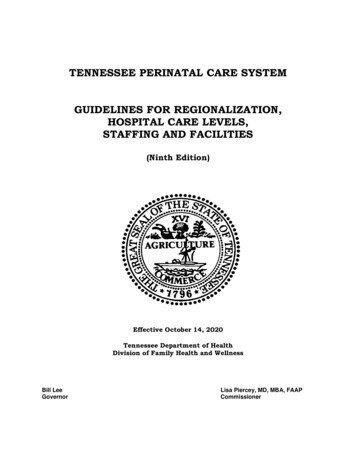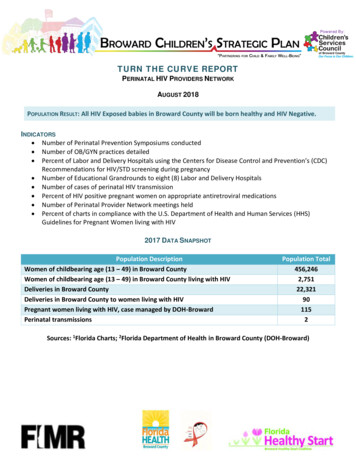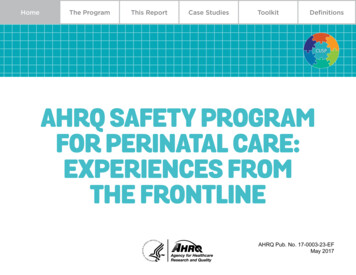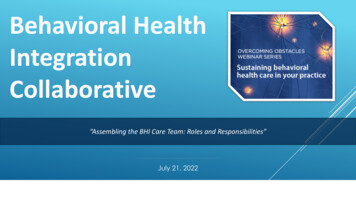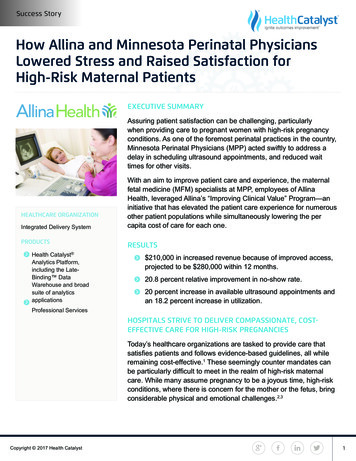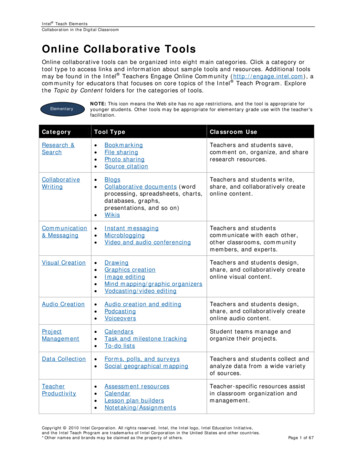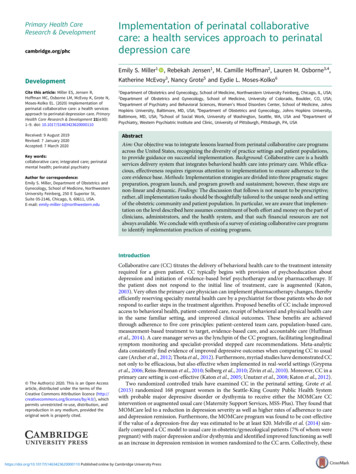
Transcription
Primary Health CareResearch & Developmentcambridge.org/phcImplementation of perinatal collaborativecare: a health services approach to perinataldepression careEmily S. Miller1 , Rebekah Jensen1, M. Camille Hoffman2, Lauren M. Osborne3,4,DevelopmentCite this article: Miller ES, Jensen R,Hoffman MC, Osborne LM, McEvoy K, Grote N,Moses-Kolko EL. (2020) Implementation ofperinatal collaborative care: a health servicesapproach to perinatal depression care. PrimaryHealth Care Research & Development 21(e30):1–9. doi: 10.1017/S1463423620000110Received: 9 August 2019Revised: 7 January 2020Accepted: 7 March 2020Key words:collaborative care; integrated care; perinatalmental health; perinatal psychiatryAuthor for correspondence:Emily S. Miller, Department of Obstetrics andGynecology, School of Medicine, NorthwesternUniversity Feinberg, 250 E Superior St,Suite 05-2146, Chicago, IL 60611, USA.E-mail: emily-miller-1@northwestern.eduKatherine McEvoy3, Nancy Grote5 and Eydie L. Moses-Kolko61Department of Obstetrics and Gynecology, School of Medicine, Northwestern University Feinberg, Chicago, IL, USA;Department of Obstetrics and Gynecology, School of Medicine, University of Colorado, Boulder, CO, USA;3Department of Psychiatry and Behavioral Sciences, Women’s Mood Disorders Center, School of Medicine, JohnsHopkins University, Baltimore, MD, USA; 4Department of Obstetrics and Gynecology, Johns Hopkins University,Baltimore, MD, USA; 5School of Social Work, University of Washington, Seattle, WA, USA and 6Department ofPsychiatry, Western Psychiatric Institute and Clinic, University of Pittsburgh, Pittsburgh, PA, USA2AbstractAim: Our objective was to integrate lessons learned from perinatal collaborative care programsacross the United States, recognizing the diversity of practice settings and patient populations,to provide guidance on successful implementation. Background: Collaborative care is a healthservices delivery system that integrates behavioral health care into primary care. While efficacious, effectiveness requires rigorous attention to implementation to ensure adherence to thecore evidence base. Methods: Implementation strategies are divided into three pragmatic stages:preparation, program launch, and program growth and sustainment; however, these steps arenon-linear and dynamic. Findings: The discussion that follows is not meant to be prescriptive;rather, all implementation tasks should be thoughtfully tailored to the unique needs and settingof the obstetric community and patient population. In particular, we are aware that implementation on the level described here assumes commitment of both effort and money on the part ofclinicians, administrators, and the health system, and that such financial resources are notalways available. We conclude with synthesis of a survey of existing collaborative care programsto identify implementation practices of existing programs.Introduction The Author(s) 2020. This is an Open Accessarticle, distributed under the terms of theCreative Commons Attribution licence (http://creativecommons.org/licenses/by/4.0/), whichpermits unrestricted re-use, distribution, andreproduction in any medium, provided theoriginal work is properly cited.Collaborative care (CC) titrates the delivery of behavioral health care to the treatment intensityrequired for a given patient. CC typically begins with provision of psychoeducation aboutdepression and initiation of evidence-based brief psychotherapy and/or pharmacotherapy. Ifthe patient does not respond to the initial line of treatment, care is augmented (Katon,2003). Very often the primary care physician can implement pharmacotherapy changes, therebyefficiently reserving specialty mental health care by a psychiatrist for those patients who do notrespond to earlier steps in the treatment algorithm. Proposed benefits of CC include improvedaccess to behavioral health, patient-centered care, receipt of behavioral and physical health carein the same familiar setting, and improved clinical outcomes. These benefits are achievedthrough adherence to five core principles: patient-centered team care, population-based care,measurement-based treatment to target, evidence-based care, and accountable care (Huffmanet al., 2014). A care manager serves as the lynchpin of the CC program, facilitating longitudinalsymptom monitoring and specialist-provided stepped care recommendations. Meta-analyticdata consistently find evidence of improved depressive outcomes when comparing CC to usualcare (Archer et al., 2012; Thota et al., 2012). Furthermore, myriad studies have demonstrated CCnot only to be efficacious, but also effective when implemented in real-world settings (Grypmaet al., 2006; Reiss-Brennan et al., 2010; Solberg et al., 2010; Zivin et al., 2010). Moreover, CC in aprimary care setting is cost-effective (Katon et al., 2005; Unutzer et al., 2008; Katon et al., 2012).Two randomized controlled trials have examined CC in the perinatal setting. Grote et al.(2015) randomized 168 pregnant women in the Seattle-King County Public Health Systemwith probable major depressive disorder or dysthymia to receive either the MOMCare CCintervention or augmented usual care (Maternity Support Services, MSS-Plus). They found thatMOMCare led to a reduction in depression severity as well as higher rates of adherence to careand depression remission. Furthermore, the MOMCare program was found to be cost-effectiveif the value of a depression-free day was estimated to be at least 20. Melville et al. (2014) similarly compared a CC model to usual care in obstetric/gynecological patients (7% of whom werepregnant) with major depression and/or dysthymia and identified improved functioning as wellas an increase in depression remission in women randomized to the CC arm. Collectively, thesehttps://doi.org/10.1017/S1463423620000110 Published online by Cambridge University Press
2data demonstrate perinatal CC to be efficacious. Importantly, thesetrials were conducted in two disparate care settings: MOMCarewas conducted in a federally qualified health center, a system serving predominantly low-income women with a focus on primarycare. Dr. Melville’s trial was conducted in two academic urbanobstetrics and gynecology clinics serving a socioeconomicallydiverse population with a mix of insurers but under a more traditional obstetrics model. The demonstrated efficacy in each of thesesettings enhances the likelihood of external generalizability to abroad array of populations and practice types.Despite these promising data, scant information is availableregarding implementation of perinatal CC in the absence of theinfrastructure and resources garnered in randomized trials(Lomonaco-Haycraft et al., 2018). This is particularly salient inthe perinatal setting given the nuances in the obstetric health system, clinician comfort with the management of depression, andpatient-level barriers (and facilitators) to engaging in mental healthcare. Moreover, how CC billing codes are conceptualized inbundled maternity payments remains an area of uncertainty withrespect to the systems-level cost of implementation.Emily S. Miller et al.Table 1. Core responsibilities of a behavioral care managerReferralsAccept referrals via various providers andcommunication methodsEnrollmentLead the patient enrollment process, gatheringand recording relevant information in the patienttracking toolAssessmentConduct brief clinical assessment to establishprobable diagnosis, risk of harm, level of need,and preliminary treatment planTreatmentConsult with a collaborative care psychiatristregarding pharmacotherapy; provide evidencebased brief psychotherapy; provide therapeuticsupport to patients as necessaryMonitoringEnsure treatment to target: monitor self-reportedscreenings and follow protocols to reachtherapeutic dose of medication and/or therapyfrequencyCommunicationFacilitate communication between obstetricproviders and patients to ensure collaborationand functional treatment planAdministrationIdentify challenges in work flow to be addressed.PreparationLaying the foundation for CC through effective preparation takes timeand is paramount to a successful program. The AIMS Center at theUniversity of Washington offers a comprehensive ImplementationGuide focused on implementation of CC in the primary care ementation-guide).Many of these resources can prove beneficial in planning forprogrammatic development in the perinatal setting.strengths and limitations, is a critical component to tailoring theprogram to meet existing clinical gaps. Finally, it is critical toassess readiness to change, measured by obstetrician motivationto become involved in behavioral health issues, satisfaction withthe existing model, and recognition that mental health is an important aspect of perinatal health.Behavioral care managerNeeds and strengths assessmentThe first step in program preparation is a data-driven needs assessment to determine the obstetric patient volume within the care system and the magnitude of the at-risk population. Specifically,depression screening patterns of obstetric providers must beunderstood. While multiple national professional organizationsendorse both antenatal and postpartum depression screening(American College of Obstetrics and Gynecology, 2008; Siu et al.,2016; Kendig et al., 2017), organizations or individual practicegroups may not have yet successfully implemented universalscreening practices. Often after the woman is screened and meetscriteria for depression, those who completed the screening do notknow the most effective resources to help her. Behavioral healthservices are rarely co-located, and they are often fragmentedthroughout the community and have long wait-lists. Thus, whilea CC program may improve screening rates, understanding theexisting culture allows for better estimations of anticipated antenatal and postpartum mental health needs.Obstetric care providers’ perspectives on their scope of practiceare another critical component of the needs assessment. CCrequires the obstetric clinician to be the primary prescriber of pharmacotherapy, with the psychiatrist serving primarily in a consultative role. The American College of Obstetricians and Gynecologistssupports the role of obstetric care providers in provision of psychopharmacologic agents (American College of Obstetrics andGynecology, 2015), but it is important to gauge both obstetricians’willingness to engage in the CC model and the scope(s) of psychiatric morbidities the obstetricians are comfortable co-managingwith the CC team. Similarly, understanding existing behavioralhealth resources serving the target patient population, with theirhttps://doi.org/10.1017/S1463423620000110 Published online by Cambridge University PressThe behavioral care manager is the lynchpin of CC, and the successof the program is tightly linked to this role. Care managers arebehavioral health professionals, often a clinical social worker, psychologist, or nurse by training, and serve as the primary contactpoint for patients and obstetricians alike. The core responsibilitiesfor the care manager are described in Table 1. Licensure to conductevidence-based brief psychotherapy is helpful to facilitate care andachieve revenue generation when CC codes are not available foruse (see Funding Strategy below).Knowledge of the CC model is essential, and several trainings onintegrated and CC are available for the behavioral care manager(Table 2). While some background knowledge in women’s healthis useful, a targeted orientation can be provided to fill in any knowledge voids. Relevant training topics may include a brief overview ofstandard prenatal care, introduction to perinatal complications andperinatal loss, unique features of perinatal mood disorders (including epidemiology, clinical presentation, and perinatal psychopharmacology), and, in some CC models, training in evidence-basedbrief psychotherapy (e.g., problem-solving therapy13 or brief interpersonal psychotherapy12). It is essential that the care managerunderstands the culture of the local obstetric clinic, includingexisting patient care and clinical work flow. The following skillsare assets to the role of a CC manager: excellent communication,leadership, team orientation, flexibility, enthusiasm, initiative,teaching/training, attention to detail, generosity, and warmth.Stakeholders and championsA multidisciplinary approach is essential to CC implementation.In general, the planning team should include the CC manager
Primary Health Care Research & Development3Table 2. Integrated care training programs for care managersInstitutionTrainingDuration of trainingModalityUniversity of WashingtonAIMS CenterCare Manager Role – ClinicalSkills40 minOnline videoAmerican PsychiatricAssociationFoundational Concepts of theCare Manager90 minOnline modulesUniversity of MassachusettsMedical SchoolPrimary Care Behavioral HealthCertificate Program22 e-learning modules, each takes90–120 minSelf-guided, web-basedUniversity of MichiganCertificate in IntegratedBehavioral Health andPrimary Care34 h (50 of continuing educationcredit)Web-based – mix of live andpre-recorded lecturesRadford University (Virginia)Behavioral Health andIntegration Training Institute40 h of continuing education in oneweekIn-personFarleigh DickinsonUniversityCertificate Program in IntegratedPrimary Care80 h of continuing education –5 units with four modules each,completed over 20 weeksWeb-basedand clinical and administrative leaders from both obstetrics andpsychiatry. Patients can also be engaged in program development;focus groups to establish patient needs and patient-identifiedbarriers to engaging in mental health treatment may guide specificprogrammatic foci. Clinical stakeholders should include a representative from each obstetric clinic served, to ensure that theirspecific needs are met. The perinatal psychiatrist and therapistwho will be involved in clinical consultation and supervisionshould provide their perspectives on an anticipated work flow thatserves the interest of the obstetric patient population involvingboth short-term treatment and team collaboration to optimizeaccess to services for patients in greatest need.From an administrative perspective, practice managers and, inan academic setting, department administrators, offer importantperspectives ranging from physical space availability (see SelectPhysical Space below), insurance alignment, and clear delineationof responsibilities for pre-certification for mental health benefits,billing, and tracking the electronic medical record (EMR) chargecapture. The newly developed CC codes (Centers for Medicareand Medicaid Services, 2019) offer financial support for implementation of the CC model and should be thoughtfully incorporated.Of note, maternity care services are, via some insurers, paid forutilizing bundled payments. How these CC codes integrate withsystems of bundled payment remains unclear.Divergent reimbursement practices represent a common barrierto implementation of CC (Kathol et al., 2010). Often insurancesaccepted by the obstetric clinics do not align with those acceptedby mental health providers. Obstetricians may be less likely toparticipate in a CC program when only a subsection of their patients,those covered by select plans, can receive mental health care.Development of creative solutions to enable universal participationin CC for all obstetric patients optimizes the likelihood of success.The CC ‘team’ should eventually grow through incorporation ofpractice champions among the front desk and clinical staff andmodeling of ‘best practices’ by the team. Engagement of championssurpasses simple buy-in but rather provides the obstetric practice asense of ownership in the CC model, which includes opportunitiesfor regular feedback and frequent communication. Early team andchampion meetings can clarify the model of CC, define the scope ofthe program, and highlight needs for additional education 110 Published online by Cambridge University PressScreening toolsEvidence-based screenings are another key feature of CC. At a minimum, the implementation team should select validated screening(s)for depression (e.g., Patient Health Questionnaire-9 (PHQ-9)(Kroenke et al., 2001), Edinburgh Postnatal Depression Scale(EPDS) (Cox et al., 1987), anxiety (e.g., Generalized AnxietyDisorder-7 item scale (GAD-7) (Spitzer et al., 2006), PerinatalAnxiety Screening Scale (PASS) (Somerville et al., 2014)), andbipolar disorder (e.g., Mood Disorder Questionnaire (MDQ)(Hirschfeld et al., 2000), WHIPLASHED clinician administeredinterview (Mahmoud et al., 2019)). It is recommended that allobstetric patients are screened by the obstetric clinicians both antenatally and postpartum using a validated screening tool (AmericanCollege of Obstetrics and Gynecology, 2015; Siu et al., 2016). Thesame instrument utilized by the obstetrician for screening shouldbe repeated at subsequent behavioral health visits to monitor forimprovement. To support treatment to target (i.e., achieving remission of symptoms), particularly in the context of postpartum carewhen in-person visits are less frequent, symptom monitoring mayinclude serial electronic delivery of the symptom screen(s) usingHealth Insurance Portability and Accountability Act (HIPAA)compliant email surveys or phone calls with a frequency of screensinformed by the severity of symptoms endorsed. Telephone-basedvisits to assess symptoms can also be used. This surveillance allowsfor discussion and adjustment of the care plan at intervals more frequent than in-person office visits.The GAD-7, PASS, or high scores (2-3) on the EPDS questions4, 5, and 6, can quantify anxiety symptoms, as depression andanxiety are highly comorbid in the perinatal period. For womenwith a positive screen for anxiety, following anxiety symptomatology via electronic screens, similar to the PHQ-9 described above,may identify exacerbations in symptoms that require intervention.The MDQ or WHIPLASHED can help to rule out bipolar disorder, which is especially important if an obstetrician or midwife isconsidering starting an antidepressant. While a significant minority of perinatal women with a positive depression screen will have adiagnosis of bipolar disorder (Wisner et al., 2013), screening forbipolar disorder is not routinely performed by obstetricians.Systematic baseline screening enables identification of womenfor whom psychiatric consultation is prudent prior to initiationof pharmacotherapy.
4Emily S. Miller et al.Figure 1. Example of spectrum of care offeredvia perinatal collaborative care.Some programs screen enrolled patients with the AdverseChildhood Experience Questionnaire and the Post-traumaticstress disorder Checklist – Civilian Version. Correlation betweentrauma and perinatal depression is strong (Garabedian et al.,2011; Dennis and Vigod, 2013; Seng et al., 2013), and these twotools quickly provide helpful clinical information to inform riskand anticipated clinical outcome trajectories (Grote et al., 2016).each with unique challenges and benefits. The AIMS Center atthe University of Washington offers two resources available foruse -tracker).The Epic EMR system has developed Epic Health Planet as apopulation management system that can be used within CC programs. Other web-based, HIPAA-compliant data servers, such asREDCap, with capacity to e-mail mental health screens can alsobe used.Population servedThe original randomized trials (Unutzer et al., 2002; Archer et al.,2012; Thota et al., 2012) and implementation studies (Grypmaet al., 2006; Reiss-Brennan et al., 2010; Solberg et al., 2010; Zivinet al., 2010) of the CC model focused on major depressive disorder.However, studies have demonstrated benefit of the CC model withother psychiatric morbidities such as anxiety disorders (Roy-Byrneet al., 2010), bipolar disorder (van der Voort et al., 2015), and substance use disorders (Watkins et al., 2017). Clear delineation ofthe scope of care provided is essential to ensure appropriate CCstaffing (Figure 1). As many obstetric providers are not trainedin managing mental illness other than uncomplicated depressionand anxiety, the perinatal psychiatrist will need to be able to primarily manage a subset of referred women with more complex orsevere mental illness. Conversely, systematic exclusion of thesewomen from the CC program requires clear advanced communication to the referring obstetric providers regarding the scope ofcare that the CC program will provide. Furthermore, it shouldbe recognized that women may be referred to the program withperinatal depression suspected by their obstetric providers but ultimate diagnoses of bipolar disorder are made. A detailed planshould be made for management of these clinical scenarios. Itshould also be recognized that complicated inclusion or exclusioncriteria for the CC program may serve as a barrier to obstetric provider referrals.Population-based trackingMeasurement-based treatment to target is one of the core principals of CC. There are various options for patient registry tools,https://doi.org/10.1017/S1463423620000110 Published online by Cambridge University PressClinical care algorithmsClinical protocols for the approach to screening, response to positive screens, initiation of evidence-based brief psychotherapy and/or antidepressants, and dose adjustment are helpful to develop andshare between the CC team and obstetric providers. Evidencebased flow sheets that succinctly illustrate key concepts can be developed in collaboration with obstetric stakeholders. While individualized care plans may be developed, standardizing the generalapproach to the planned stepped care algorithm will foster obstetrician comfort with screening and primary pharmacotherapymanagement. Examples of algorithms used in NorthwesternMedicine’s CC program (COMPASS) are included in the Appendix.FundingCC is a relatively new way of delivering care, and identifying available funding is beneficial to launch such innovation. A compellingneeds assessment and presentation of the evidence base may persuade organizational leaders to fund a CC program. Many aspectsof the CC model had been subject to limited opportunities forreimbursement, but newer adoption and expansion of CC billingcodes are facilitators of implementation. The specific tasks thatfall under the rubric of these time-based billing codes are describedbelow.Population-based care and measurement-based treatment totarget require rigorous patient tracking. While freely availableexisting spreadsheets and tracking systems have been developedas described above, linkage of these clinical data to any existingEMR system can be costly. Furthermore, active patient reminders,
Primary Health Care Research & Developmentsurveillance for completion of screens, and communicationregarding stepped care recommendations is time-consuming.In October 2017, Centers for Medicare and Medicaid Servicesapproved Medicare reimbursement for these essential CC services(Oquendo, 2016). As more commercial payers have followed suit,reimbursement for these services may facilitate financial stability ofperinatal CC programs.Another cost is coverage of mental health care in the setting ofinsurance non-alignment between obstetric and mental healthteams. As described previously, obstetricians are less likely toengage in CC when only a subsection of their patients are eligiblefor behavioral health care in the CC program, and this is particularly true in the nuanced setting of identifying mental health insurance benefits. Optimization of insurance alignment and/or fundingto support empiric care provision for women whose insurances donot allow for the CC mental health care provision improves thechances of successful implementation.One additional area of revenue generation by the care manager,when CC billing codes are unavailable, is via clinical evaluation andevidence-based brief psychotherapy provision. As described above,care manager licensure to complete these tasks is beneficial programmatically. Nevertheless, given the myriad responsibilities ofthe care manager in meeting CC standards, the amount of timespent delivering therapy needs to be carefully balanced with thepopulation-level coordination needs of the program.Physical spaceConsiderations must be made both for the location of the care manager as well as for any direct psychiatric care that will be providedwithin the CC program clinic. Ideally, CC is co-located care, with thecare manager, perinatal psychiatrist, and therapist located withinthe prenatal offices. Co-location of the care manager should be prioritized as it affords ongoing programmatic awareness, ‘curb-side’consultations, and warm patient handoffs to occur. If co-locationis not an option, it is critical to establish reliable communicationchannels between the collaborating providers, such as a direct phonenumber, pager, secure messaging tool, and/or regular meetings.Program launchCreating awarenessWhile obstetric providers will have been involved in the planningprocess, ensuring awareness of the program’s launch is essential.Methods of systemic notification of stakeholders include newsletterannouncements, departmental/practice meetings, and/or grandrounds. Essential contact information (e.g., phone number, pager,office hours) for members of the CC team should be included inthese communications ensuring that front desk employees, medicalassistants, nurses, doctors, and office administrators have updatedprogrammatic information. Professional and stigma-reducing brochures or fliers give credence to a new program and can be placed inpatient exam rooms and physician workspaces as a talking point andtake-home resource for patients. The clinical care algorithms developed in the planning phase should be made readily available forquick reference by obstetric providers.Ensuring the entire obstetric care team is aware andengagedLaunch time is the perfect opportunity to engage all members ofthe patient experience in the shared vision for CC. Front desk staff,https://doi.org/10.1017/S1463423620000110 Published online by Cambridge University Press5medical assistants, and nurses are indispensable to workflow andprogrammatic success. For example, front desk personnel areresponsible for correctly scheduling new types of patients andensuring billing information is accurate. Their awareness andengagement in programmatic launch enables seamless registrationand claims processing. Medical assistants are often involved in theinitial depression screen administration, can also universally offerpatient educational materials in new patient packets, and assistwith warm handoffs during an in-office referral. Obstetric officenurses often respond to patient calls or messages and can be pivotalin initiating successful referrals. They are an important referralsource in assisting the CC team with follow-up and engagement.Tailored messaging to all members of the team regarding thelaunch date and their role in the program will cultivate the neededteam approach to optimizing patient care.Clinical care team meetingsA core tenet of CC is population-based care, engaging mentalhealth specialists in providing caseload-focused consultation.Meeting duration can be tailored to the complexity of cases discussed but in general should occur weekly to ensure that womenengaged in the CC program are being actively managed. To facilitate attendance of all CC team members at these weekly meetings,some programs conduct the meetings via video conference. Priorto each meeting, the care manager reviews the registry to identifywomen who are not improving according to anticipated trajectories as well as any other complicated cases. Preparation for thesecase review meetings ensures a systematic review of patient engagement and symptom assessment, allowing the care manager toprovide targeted outreach to women who have not engaged inscreenings or care.In addition to the care manager, these clinically focused meetings should include all CC mental health providers (i.e., psychiatrist(s) and behavioral health therapist(s)) as well as, ideally,obstetrician stakeholder(s) to ensure the program’s responsivenessto the needs of the obstetric clinicians. A multidisciplinaryapproach allows for rich discussion and development of plans tailored to the perinatal context. Care plans developed as a result ofthese meetings are then communicated back to patients and theirobstetric providers to enable stepped care plans to be implemented.DocumentationAn integrated EMR is an enormous asset to CC. Ideally, behavioralhealth encounters are visible to all providers in the same medicalrecord as obstetric care. Requiring obstetric providers to ‘breakthe glass’ or otherwise pass by a fire wall between obstetric andmental health notes decreases communication between teamsand increases stigma surrounding mental health treatment. A jointrecord system enables obstetricians to visualize the behavioralhealth intake notes by the care manager. These notes includethe initial discussion with each new patient, whether in-personor phone-based. This note includes basic information about thepatient’s symptoms, mental health history, treatment preferences,treatment plan, and intake screening scores. This is a quick reference point for all members of the care team.Other useful components of the EMR include identification of acentralized location for depression screens, such as a flow sheet,that enables both mental health and obstetric providers to visualizesymptom trajectories over time. In addition, utilization of a centralized problem list, briefly outlining the diagnosis and treatment
6Emily S. Miller et al.Figure 2. Stepped care model.Figure 3. Core collaborative care principles reported bysurvey respondents.plan, allows for quick reference to
perinatal collaborative care: a health services approach toperinatal depression care. Primary Health Care Research & Development 21(e30): 1-9. doi: 10.1017/S1463423620000110 Received: 9 August 2019 Revised: 7 January 2020 Accepted: 7 March 2020 Key words: collaborative care; integrated care; perinatal mental health; perinatal psychiatry


